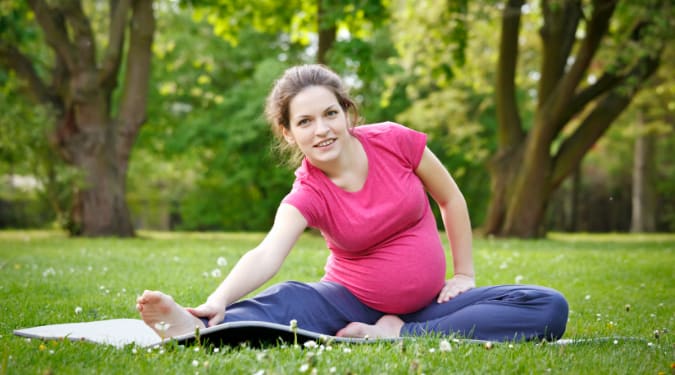 Exercise is good for just about everything. We already know that! But what about exercising for two? Yes, when you are pregnant, exercise is even more important. (Sorry men, but this one is for the wives). According to Farel Hruska who is the national fitness director of FIT4MOM, a woman’s body changes more in 9 months of pregnancy that a man’s changes in his entire lifetime.
Exercise is good for just about everything. We already know that! But what about exercising for two? Yes, when you are pregnant, exercise is even more important. (Sorry men, but this one is for the wives). According to Farel Hruska who is the national fitness director of FIT4MOM, a woman’s body changes more in 9 months of pregnancy that a man’s changes in his entire lifetime.
Aside from the many benefits you will get from exercising, your unborn baby will also benefit greatly. Exercise can actually improve your baby’s health into adulthood. Babies of moms who exercise during pregnancy are born at healthier weights, are better able to weather labor and delivery (they are less stressed by it), and recover from the stresses of birth more quickly. In addition, heart rates of babies whose mothers exercise are more stable during and after labor and recent research also shows that babies of exercisers have a more active and mature brain function. Researchers now believe these children might end up being smarter than average. Unfortunately, most women don’t exercise during pregnancy and therefore, don’t reap the benefits of doing so.
The main goal for pregnant women in exercise is function. Within functional training, there are three events for which we have to train. 1) Become active if you are currently sedentary. This can help you with overall health. 2) If there is a particular way or position you like to give birth in, train to strengthen those muscles. 3) Work on general overall strength so after your birth you will be able to function well as a mother after birth and be able to return quicker to your normal self.
Natural changes in pregnancy cause increased joint laxity, which accommodates a growing uterus and helps prepare for childbirth. This makes a woman more flexible than normal and she therefore needs to be careful during stretching exercises not to overstretch. We all know that women gain weight in pregnancy. Average healthy weight gain for non-overweight women should be 25-35 pounds (11-16 kilo). Increased lower-back and pelvic pain is also typical. About half of pregnant women get pelvic pain and a third get lower back pain. Posture also changes during pregnancy and weak abdominal muscles can cause this to be exacerbated. With both abdominal and chest growth, we tend to be pulled down by gravity, which needs to be counteracted
It is very important during the first trimester to concentrate on your core strength and abdominal exercises. Later in pregnancy it isn’t good to be on your back too much as the fetus pushes down on major blood vessels when you are on your back. So earlier is the time to concentrate on these muscles. This will help you later in pregnancy with your postural issues. This is also the time to begin working the pelvic floor to strengthen her bladder and urinary tract. This can help both short-term and long-term incontinence.
Aside from being on your back, there is very little a pregnant woman can’t do all through pregnancy. Aerobics, resistance training and flexibility exercises are all essential to your good health just like if you aren’t pregnant. There is a 27% less chance of gestational diabetes for people that engage in aerobic exercise 4 days per week throughout the pregnancy.
There are circumstances where exercise should cease immediately. You should speak you’re your doctor before exercising if you have any concerns. According to the American Congress of Obstetricians and Gynecologists, stop exercising immediately if you have any of the following:
- Vaginal bleeding
- Shortness of breath prior to exertion
- Dizziness
- Headache
- Chest pain
- Muscle weakness
- Calf pain or swelling
- Preterm labor
- Decreased fetal movement
- Amniotic fluid leakage
Lisa Westlake, a physical therapist and author of the book ‘Exercising for Two” reminds us that exercise during pregnancy is to maintain the health of the mother and the baby and to prepare the body for birth. This is not the time to get super-fit. Westlake also says the “There is never a more important time than pregnancy to listen to your body. Expectant women should find a healthy balance between rest and exercise and remember it is a short time in the big picture.”
Postpartum Exercise
The American College of Obstetricians and Gynecologists (ACOG) says its okay to gradually resume exercising as soon as you feel up to it. But your doctor or midwife may want you to wait until your six-week postpartum checkup to see how you’re doing first. Generally, if you exercised throughout your pregnancy and had a normal vaginal delivery, you can safely do light exercise – walking, modified push-ups, and stretching – within days of giving birth. Start slowly with a low-impact aerobic activity such as walking. As you regain strength, you can increase the length, intensity and number of walks.
If you had a c-section, check with your doctor first and expect to wait until you recover from your operation before beginning an exercise program. An incision from a c-section takes at least several weeks to heal, and it may be some time after that before you feel like working out. However, walking at an easy pace is encouraged because it promotes healing and helps prevent blood clots and other complications. If you weren’t active during your pregnancy, or tapered off your fitness routine as the weeks went on, check with your doctor or midwife before you begin exercising. In any case, remember that your joints and ligaments will still be loose for about three to five months, so watch your step to avoid falling.
Exercise is good for you, but don’t overdo it for the first few months after giving birth. Your body needs time to heal, and you need time to adjust to your new role – and bond with your baby.
Exercising responsibly during pregnancy is good for health, your function, the baby and will benefit you greatly after birth and will “add hours to your days, days to your years, and years to your life.”
Alan Freishtat is an A.C.E. CERTIFIED PERSONAL TRAINER and a BEHAVIORAL CHANGE and WELLNESS COACH with over 19 years of professional experience. Alan is the creator and director of the “10 Weeks to Health” program for weight loss. He is available for private coaching sessions, consultations, assessments and personalized workout programs both in his office and by telephone and skype. Alan also lectures and gives seminars and workshops. He can be reached at 02-651-8502 or 050-555-7175, or by email at alan@alanfitness.com Check out the his web site –www.alanfitness.com US Line: 516-568-5027.
The words of this author reflect his/her own opinions and do not necessarily represent the official position of the Orthodox Union.

